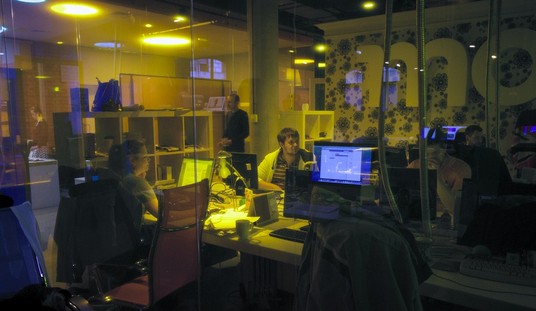
A veteran Timesman dishes a little dirt on his recently sacked former editor. Donald G. McNeil Jr., a science correspondent who describes himself as being with the Times for almost 40 years emails a letter to the MSM house organ Jim Romenesko.com:
[C]onsider this lede, from a 2006 review of “The Lionesses” about female journalists.
I worked for many years as an investigative reporter in Washington, digging into all manner of government grubbiness for The Wall Street Journal and The New York Times. In this trench-coated, gumshoe world, I only occasionally encountered other women among the journalists poring over documents in obscure federal agencies or pounding on the closed doors of K Street, the capital’s famous corridor of lobbyists. By long tradition, this was men’s turf. It was telling that one of my colleagues once anonymously described me in a published profile as having “balls like cast-iron cantaloupes.”
Byline: Jill Abramson. Those of us below the rank of managing editor are simply not allowed to write like that.
Some of us old enough to remember Donald and Ivana Trump’s divorce playing out for weeks on the front pages of the News and Post wish this would all just stop. The only thing Jill could have done more mortifying than the boxing pic would have been to pose in an Angela Davis wig with her fist raised. But this flow of “let’s correct the record” notes also prolongs the tit-for-tat. Public spats hurt the Times[.]
McNeil writes that those like himself at the New York Times “below the rank of managing editor are simply not allowed to write like that.” But could any male at the modern New York Times describe himself in such terms? If any Timesman had the insouciance to actually use such macho language, for once, the Times’ vaunted layers and layers of editors would ensure that such rabid hate speech would never make it past the paper’s in-house computer network, let alone into ink.
But gender inequalities aside, I’m not sure why Abramson wouldn’t pose like Angela Davis (who just pocketed a reported and very capitalistic $20,000 for a speech this past Friday at Dartmouth sponsored by the campus “Gender Research Institute”), considering that the Times published a fawning profile of Bill Ayers celebrating his bombing of the Pentagon on, in a deeply macabre coincidence, the morning of September 11, 2001. And in December of 2002, the New York Times ran a profile of a young Yale student named Chesa Boudin, who had just been awarded a prestigious Rhodes Scholarship, as Bernie Goldberg wrote in 2004 book Arrogance:
It turns out that young Mr. Boudin is the son of David Gilbert and Kathy Boudin, two members of the sixties radical group Weather Underground, who have been in prison for more than twenty years for their part in a 1981 robbery of a Brinks truck that left two policemen and a guard dead. And because his parents were in prison, Chesa Boudin was raised by two other members of the radical group, Bernadine Dohrn and Bill Ayers.
Yes, that Bill Ayers.
Now it was young Chesa Boudin’s turn to be canonized by the New York Times, whose reporter, Jodi Wilogren, tells us about how he overcame “striking challenges” while growing up, how he dealt with his epilepsy and his dyslexia and his “temper tantrums.” Chesa Boudin, of course, should not be condemned for the acts of his parents. No, he should be condemned entirely on his own merits.
An antiwar activist at Yale, he believes his parents were heroes. “We have a different name for the war we’re fighting now,” he tells the admiring Times reporter. “Now we call it the war on terrorism; then they called it the war on Communism. My parents were all dedicated to fighting U.S. imperialism around the world. I’m dedicated to the same thing.”
As Goldberg goes on to write, while Boudin railed in his profile against the plight of “the homeless in Chile, the poor in Bolivia, the illiterate in Guatemala,” at no point does Boudin or the Times tell us “anything about the suffering and hardships of other children much closer to home—the nine children left behind by the policemen and the guard who were murdered, in cold blood, with the help of Chesa Boudin’s parents.” Nor, as Goldberg adds, were the dead policemen or guard ever mentioned by name in the article.
“Reading this story, barely more than a year after 9/11,” Goldberg concludes, you could only ask yourself, ‘What are the people at the New York Times thinking? Are they truly this clueless? Are they so infatuated with the infantile radicalism of the sixties that they’ve lost all sense of decency?’”
The key word there is infantile. As the atmosphere of radical chic, Pinch’s moose, Jill’s tats and her carefully staged boxing pix all remind us, “The men and women who own and operate and produce every day the world’s most important newspaper are basically children,” which helps to explain the self-serving and juvenile metaphors they use to describe themselves — and their readers.
Related:
Boom RT @themarkberman: NYT executive tells @HowardKurtz that Baquet would have quit if Abramson wasn’t fired http://t.co/nsiBBMJRKw
— Jonah Goldberg (@JonahNRO) May 18, 2014
And David Carr’s latest article from inside the belly of the beast, to borrow Bill and Bernadine’s rhetoric is summarized by a commenter at Ann Althouse’s blog: “we are on life support. No one trusts us.” Plus this:
“I understand that if I come to work at The New York Times, the needs of the many will frequently supersede the needs of the one,”
Pivot from Jason Blair to plagiarizing Spock. Nice segue.
Heh.™










Join the conversation as a VIP Member